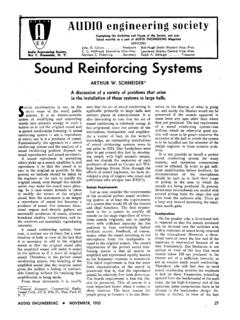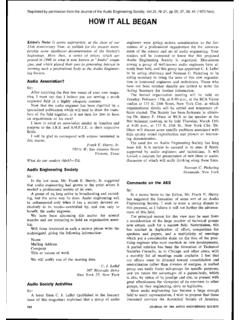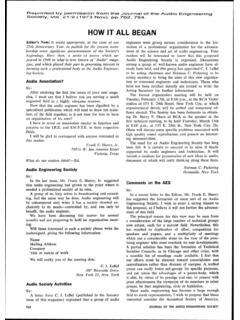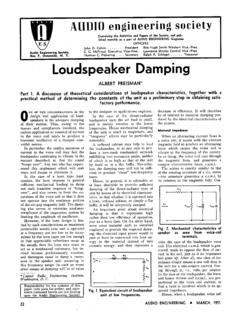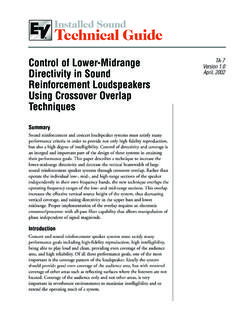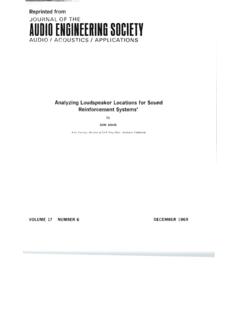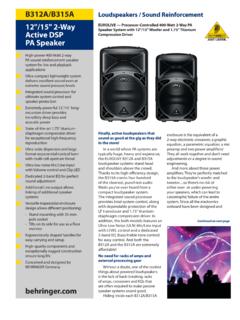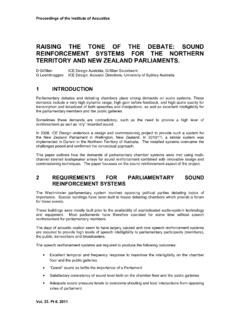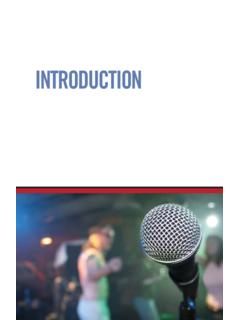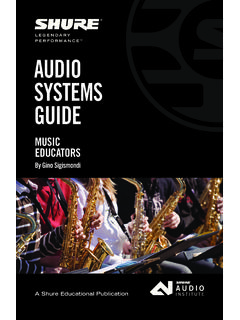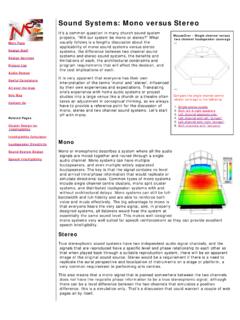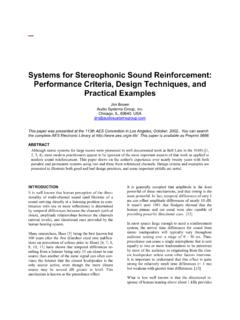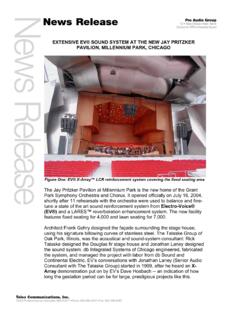Transcription of AES 59th Sound Reinforcement
1 CONFERENCE REPORT1028 J. Audio Eng. Soc., Vol. 63, No. 12, 2015 December370 J. Audio Eng. Soc., Vol. 63, No. 5, 2015 MayThe 59th AES International Confer-ence, Sound Reinforcement Engi-neering and Technology, was held July 15 17, 2015. The conference was hosted by McGill University s Schulich School of Music in the beautiful city of Montreal, Quebec, Canada. The conference was the first in over 25 years dedicated to large-scale Sound Reinforcement , public address, and live Sound , and just the third AES conference held in Canada. The prior conferences held in Canada were Audio in Digital Times held in Toronto, May 1989, and Multichannel Audio the New Reality , held in Banff May, June conference venue was The Elizabeth Wirth Music Building, sessions were held in the 180-seat Tanna Schulich recital hall, and the Multi-Media Room (MMR), an experimental laboratory and perfor-mance space.
2 The building lobby doubled as a reception space where morning coffee, lunch, and coffee breaks were served by the welcoming, friendly staff and students. The Wirth Opera Studio provided space for sponsors to showcase their latest product offerings, and one of the recording studios, Studio 22, was used for a demonstration. In short, a modern venue perfectly suited to this 59th International ConferenceSound ReinforcementEngineering and TechnologyMontreal, Canada15 17 July2015 CONFERENCE REPORTCONFERENCE REPORTJ. Audio Eng. Soc., Vol. 63, No. 12, 2015 December 1029J. Audio Eng. Soc., Vol. 63, No. 5, 2015 May 371 Sponsored byConference chairs Wieslaw Woszczyk, left, and Peter Mapp greet the audience at the opening of the conference chairs enjoy a beer during the informal reception before the conference REPORT1030 J.
3 Audio Eng. Soc., Vol. 63, No. 12, 2015 DecemberTwo years of planning and preparation by cochairs Peter Mapp and Wieslaw Woszczyk went into the event, which attracted in excess of 150 attendees from as far away as Korea, New Zealand, Japan, Brazil, and Australia. The conference had originally been conceived as a workshop/tutorial-based conference. Workshop chair Richard King worked tirelessly to coordinate a program consisting of 15 workshops, 9 tutorials, and 3 paper sessions complemented by a variety of tours, demonstrations, and social functions. Prior to the official conference, a special pre-conference day included tours of McGill University, McGill s Centre for Interdisciplinary Research in Music Media and Technology, Sound Recording Program Facilities, CBC Studios, the Soci t des Arts Technologiques, and a pre-conference aim of the conference was to create a forum for all profes-sionals working in or around the area of installed and live perfor-mance Sound to share and advance techniques, technology, and discuss current and future platforms for system applications.
4 The goal of this three-day event was to establish a higher standard for live Sound and to promote education, exploration, and innovation under the leadership of the best practitioners and technology devel-opers in the field. CONFERENCE OPENINGP eter Mapp began the proceedings by welcoming everyone, stating that some of the top experts in the field were at the conference and encouraging everyone to take the opportunity to seek them out and talk about their respective area of expertise. The podium was then handed over to Wieslaw Woszczyk who also welcomed everyone and pointed out that the conference sponsors are among the leaders of the Sound Reinforcement industry. He stated that the conference was going to be a summit of technology, engineering, and appli-cations and expressed his hope that new innovations would spring out of this talked about how he could inspire forward movement in this business.
5 For this he looked to the past and the beginnings of Sound Reinforcement , to an innovation in audio engineering from 100 years ago, the Blathaller speaker as patented by Hanns Reigger in 1924. After explaining the basic construction of the Blathaller, and playing a recording of an original implementation of the design, Woszczyk declared the 59th International Conference on Sound Reinforcement Engineering and Technology open. OPENING LECTUREP eter Mapp then presented the opening lecture titled Speech Intelligibility in Sound Reinforcement Making it Happen, open-ing with the statement if a Sound system is not intelligible, then there is not much point in having it. Mapp then went on to state that intelligibility is not a black and white parameter, that there are many shades of gray. A huge number of venues have Sound Reinforcement and public address systems, Sound Reinforcement defined as live Sound being reinforced and public address as having no acoustic source audible to the listener, for example a paging sys-tem.
6 In all cases speech content needs to be intelligible, but not to the same went on to explain that speech intelligibility is a highly nonlinear process and discussed contributing factors such as noise, echoes, distortion, and the fact that speech is very robust and has inbuilt redundancy. Small changes in signal-to-noise ratio, direct-to- reverberant ratio, and equalization can have a significant effect. These factors were then explored in detail, laying the groundwork for how speech intelligibility is measured and the basis for the Speech Transmission Index or STI. The new STI intelligibility scale was then introduced that better defines the varying degrees of intelligibility and is more descriptive when compared to the old scale. Scale categories and the type of venue where they apply were reverberation time is often associated with intelligibility, the point was made that there is no specific relationship between the two.
7 The inverse relationship between intelligibility and distance from the source was presented. The frequency contribution in the speech spectrum was compared to the octave band contribution to speech intelligibility; it was noted that the SPL of speech is greatest in the 250-Hz octave, while the octave centered at 2 kHz contributes most to intelligibility. The effect of signal-to-noise ratio on intelli-gibility was presented. It was noted that this effect is dependent on the Sound pressure level and that listener preference may not be for a linear relationship. The recognition of words as a function of frequency was discussed. The effects of reverberation time and age on intelligibility were 1 SESSIONSS ession 2 was a tutorial by Dave Gunness of Fulcrum Acoustic. His presentation was titled Loud-speaker Measurements and the Future or Understanding Loud-speaker Specifications and Per-formance by Applying Frequency Aggregation.
8 Dave introduced the concept of frequency aggre-gation and made the observation that most measures of loudspeaker performance do not consider the response to complex signals like music. Equalized sensitivity and real world max. SPL were pre-sented as the basis of a methodol-ogy for understanding real world loudspeaker performance. In Session 3, Joe Ciaudelli and Volker Schmitt presented a tuto-rial on wireless microphones. Joe covered the recent and upcoming changes in RF spectrum policy and discussed the impact on wireless microphone operation. Of particu-lar importance, the 600-MHz band will become unavailable to wire-less microphones in about three Joe Ciaudelli speaks on changes in wireless spectrum Gunness explains loudspeaker audience member poses a question during lively REPORTJ. Audio Eng. Soc., Vol. 63, No. 12, 2015 December 1031years, although other bands may become available.
9 Spectrum sharing will become the new norm, and licensed operation will become increasingly important. Joe also discussed white space devices and showed examples of wireless microphone protected Schmitt discussed digital audio wireless transmission. He presented its advantages, talked about the different types of RF modulation, and discussed the chal-lenges of transmitting high data-rate digital audio 4 combined a nicely prepared box lunch with a tour of the Maison Symphonique, organized by committee member Martha de Francisco. A short walk from the conference venue, The Maison Symphonique is a 2100-seat concert hall located in the Place des Arts. It was designed to showcase acoustic music of all genres and features a purpose-built organ designed by the house of Casavant, one of the world s premier organ builders and located just a few miles away in the city of Saint-Hyacinthe.
10 Maison Symphonique organist Jacquelin Rochette described some of the unique features of the instrument, then played several short pieces to showcase the instru-ment and the acoustics of the hall. Upon our return to the conference venue, the keynote address was given by Bob McCarthy of Meyer Sound on the topic of Sound system tuning and optimization: past, present, and future. He began by asking the question what is system optimization? He then reviewed system optimization goals such as maximum uniformity, maximum SPL capability, minimum phase variance, and minimum latency, making the point that maximum uniformity should be the primary goal. McCarthy went on to discuss intelligent Sound design. He provided a brief history of Sound system measurement instruments and techniques, focusing on the SIMM system , then concluded his presentation with a discussion of optimizations 6 was a tutorial on steered line arrays by Evert Start of Duran Audio/JBL.
